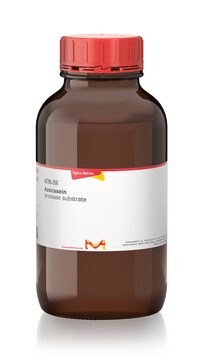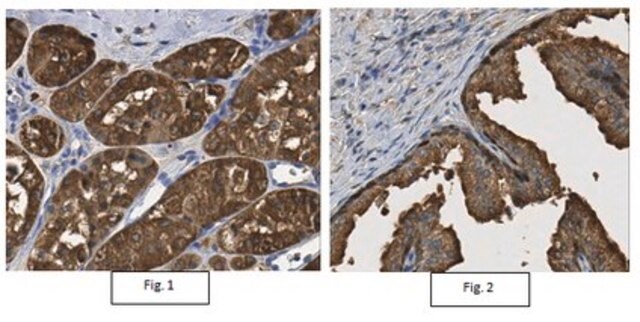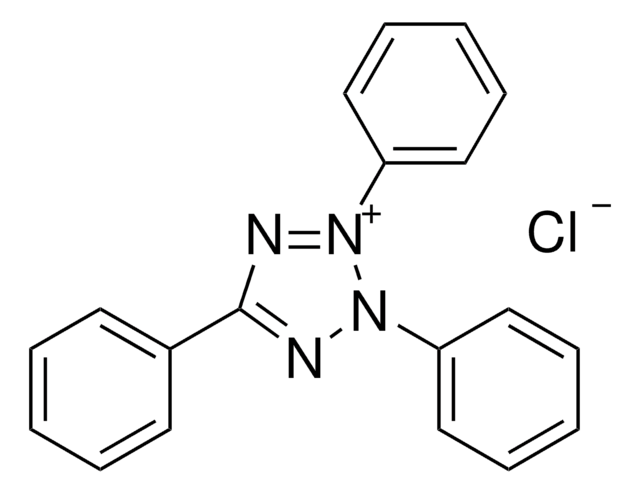V900156
Poli(etilenglicole)
Vetec™, reagent grade, avg mol wt 8,000
Sinonimo/i:
PEG
Autenticatiper visualizzare i prezzi riservati alla tua organizzazione & contrattuali
About This Item
Prodotti consigliati
Grado
reagent grade
Nome Commerciale
Vetec™
PM
avg mol wt 8,000
Stringa SMILE
C(CO)O
InChI
1S/C2H6O2/c3-1-2-4/h3-4H,1-2H2
LYCAIKOWRPUZTN-UHFFFAOYSA-N
Cerchi prodotti simili? Visita Guida al confronto tra prodotti
Descrizione generale
Polyethylene glycol (PEG) is a synthetic, hydrophilic, biocompatible polymer that has a wide range of uses in PEGylation, surface conjugation, nanoparticle coating, and crosslinking for hydrogels, etc. PEGs are made by polymerizing ethylene oxide via a ring-opening reaction.
Applicazioni
Poly(ethylene glycol) avg mol wt 8,000 can be used as:
- A stabilizing agent in the synthesis of silver nanoparticles via solid-state oxidation of silver nitrate.
- A reaction medium in the synthesis of dibenz[b,f]-1,4-oxazepine via base-catalyzed cyclization of 2-fluoro benzaldehyde and 2-amino phenol.
- A surfactant to prepare PEGylated CuO nanoparticles via hydrothermal method using Cu(NO3)2 as a precursor salt.
Note legali
Vetec is a trademark of Merck KGaA, Darmstadt, Germany
Codice della classe di stoccaggio
11 - Combustible Solids
Classe di pericolosità dell'acqua (WGK)
WGK 1
Punto d’infiammabilità (°F)
Not applicable
Punto d’infiammabilità (°C)
Not applicable
Certificati d'analisi (COA)
Cerca il Certificati d'analisi (COA) digitando il numero di lotto/batch corrispondente. I numeri di lotto o di batch sono stampati sull'etichetta dei prodotti dopo la parola ‘Lotto’ o ‘Batch’.
Possiedi già questo prodotto?
I documenti relativi ai prodotti acquistati recentemente sono disponibili nell’Archivio dei documenti.
I clienti hanno visto anche
K Giannousi et al.
Journal of inorganic biochemistry, 164, 82-90 (2016-09-26)
There is a growing field of research into the physicochemical properties of metal oxide nanoparticles (NPs) and their potential use against tumor formation, development and progression. Coated NPs with biocompatible surfactants can be incorporated into the natural metabolic pathway of
D D Smyth et al.
Cardiovascular drugs and therapy, 4(1), 297-300 (1990-02-01)
Previous studies have demonstrated that Separan AP-30, a drag-reducing polymer, significantly decreased the formation of atherosclerotic plaques in rabbits fed a high-cholesterol diet. Furthermore, Separan AP-273, a polymer similar to but longer than Separan AP-30, markedly increased cardiac output in
M Patel Geeta et al.
Current drug delivery, 6(2), 159-165 (2009-05-20)
Carbamazepine indicated for the control of epilepsy, undergoes extensive hepatic first-pass metabolism after oral administration. A vaginal dosage form of carbamazepine is not commercially available. Conventional suppository having poor retention in the vaginal tract, as they are removed in a
P I Polimeni et al.
Journal of cardiovascular pharmacology, 14(3), 374-380 (1989-09-01)
The acute hemodynamic effects of an intravenously (i.v.) injected poly(ethylene oxide), Polyox WSR N-60K (dose 50 mg/kg), were studied in the open-chest rat anesthetized with sodium pentobarbital. The injectate is one of four drag-reducing polymers known to augment in vitro
I L Konorova et al.
Patologicheskaia fiziologiia i eksperimental'naia terapiia, (4)(4), 7-9 (1991-07-01)
The search for antiaggregatory compounds is undertaken, as a rule, under in vitro conditions which do not reflect the dynamics of the real process. The present work deals with study of the peculiarities of the development of the collagen induced
Il team dei nostri ricercatori vanta grande esperienza in tutte le aree della ricerca quali Life Science, scienza dei materiali, sintesi chimica, cromatografia, discipline analitiche, ecc..
Contatta l'Assistenza Tecnica.





